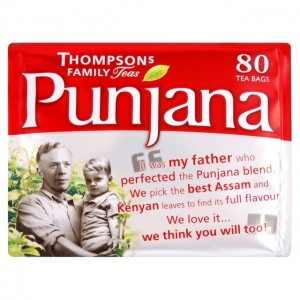Impressed by the taste of Punjana Irish Breakfast Tea, I decided to give the original blend from the same company a try. Surprisingly, the best deal I found on Punjana Original Tea — also marketed as Punjana Everyday Tea — was through the company website, Punjana.com.
I paid £6.90 (£3.80 for the tea plus £3.10 for shipping) which, after my credit card was charged, set me back $11.17. Though I didn’t realize it at the time, this price actually includes two 80-packs of tea bags. That’s $5.59 per 80 pack — not quite the deal I found at Big Lots for the Irish breakfast blend ($3.50), but certainly the best I could find online for the original blend. The only downside to purchasing directly from Punjana (if you live in the United States) is the 3-4 week delivery time.
The difference between Punjana’s original and Irish breakfast blends is not well explained on the company website. Both products contain Assam and Kenyan teas and are described as being bright and refreshing.
As expected, Punjana’s Irish Breakfast tea is stronger in aroma and flavor than Punjana Original Tea, although they both have similar characteristics. Both exhibit a sweet citrus-like aroma and are full bodied and moderately astringent.
Those who like strong tea won’t be disappointed with Punjana Original; it is, after all, an Irish tea. For something with slightly more strength and character (a result of more Kenyan in the blend, possibly?), try Punjana Irish Breakfast. After drinking both for a couple of months, other popular English and Irish breakfast tea brands, by contrast, taste like cardboard to me.


